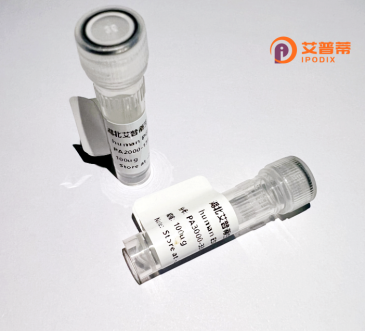
| 纯度 | >90%SDS-PAGE. |
| 种属 | Human |
| 靶点 | UBIAD1 |
| Uniprot No | Q9Y5Z9 |
| 内毒素 | < 0.01EU/μg |
| 表达宿主 | E.coli |
| 表达区间 | 1-338 aa |
| 活性数据 | MAASQVLGEKINILSGETVKAGDRDPLGNDCPEQDRLPQRSWRQKCASYVLALRPWSFSASLTPVALGSALAYRSHGVLDPRLLVGCAVAVLAVHGAGNLVNTYYDFSKGIDHKKSDDRTLVDRILEPQDVVRFGVFLYTLGCVCAACLYYLSPLKLEHLALIYFGGLSGSFLYTGGIGFKYVALGDLIILITFGPLAVMFAYAIQVGSLAIFPLVYAIPLALSTEAILHSNNTRDMESDREAGIVTLAILIGPTFSYILYNTLLFLPYLVFSILATHCTISLALPLLTIPMAFSLERQFRSQAFNKLPQRTAKLNLLLGLFYVFGIILAPAGSLPKI |
| 分子量 | 63.2 kDa |
| 蛋白标签 | GST-tag at N-terminal |
| 缓冲液 | PBS, pH7.4, containing 0.01% SKL, 1mM DTT, 5% Trehalose and Proclin300. |
| 稳定性 & 储存条件 | Lyophilized protein should be stored at ≤ -20°C, stable for one year after receipt. Reconstituted protein solution can be stored at 2-8°C for 2-7 days. Aliquots of reconstituted samples are stable at ≤ -20°C for 3 months. |
| 复溶 | Always centrifuge tubes before opening.Do not mix by vortex or pipetting. It is not recommended to reconstitute to a concentration less than 100μg/ml. Dissolve the lyophilized protein in distilled water. Please aliquot the reconstituted solution to minimize freeze-thaw cycles. |
以下是3篇关于重组人UBIAD1蛋白的关键文献摘要概括:
---
1. **文献名称**:*Human UBIAD1 is a novel vitamin K2 biosynthetic enzyme*
**作者**:Nakagawa et al. (2010)
**摘要**:首次报道UBIAD1催化维生素K2(MK-4)的合成,通过体外重组蛋白实验证实其将维生素K1转化为MK-4的酶活性,揭示其在维生素K代谢中的核心作用。
2. **文献名称**:*Structural basis of Src kinase autoinhibition and functional regulation by the polyprenol-binding protein UBIAD1*
**作者**:Yin et al. (2022)
**摘要**:解析重组UBIAD1蛋白的晶体结构,揭示其与胆固醇代谢酶HMGCR的相互作用机制,阐明了UBIAD1通过结合多萜醇调控细胞膜脂质稳态的分子机理。
3. **文献名称**:*Mutations in UBIAD1 cause Schnyder corneal dystrophy and impair vitamin K metabolism*
**作者**:McGill et al. (2013)
**摘要**:发现UBIAD1基因突变导致角膜脂质沉积病(SCD),利用重组突变体蛋白证明突变损害其维生素K合成及线粒体定位功能,为疾病机制提供直接证据。
---
**研究方向提示**:UBIAD1研究多集中于维生素K合成、角膜疾病关联及胆固醇调节,近年聚焦其结构解析与代谢调控网络。建议补充检索近年线粒体功能或癌症相关研究,以拓展重组蛋白应用场景。
UBIAD1 (UbiA prenyltransferase domain-containing protein 1) is a conserved enzyme belonging to the UbiA family of membrane-bound prenyltransferases. It plays a critical role in lipid metabolism, notably in the biosynthesis of vitamin K₂ and coenzyme Q₁₀ (CoQ₁₀), essential molecules for blood clotting, mitochondrial respiration, and antioxidant defense. UBIAD1 localizes to the endoplasmic reticulum and mitochondria-associated membranes, where it catalyzes the prenylation of aromatic substrates using isoprenyl diphosphates.
Clinically, UBIAD1 mutations are linked to Schnyder corneal dystrophy (SCD), a rare autosomal dominant disorder characterized by corneal cholesterol and phospholipid accumulation, leading to vision impairment. Studies suggest UBIAD1’s involvement in cholesterol trafficking and homeostasis, with SCD-associated mutants impairing its ability to regulate intracellular lipid balance.
Emerging research highlights UBIAD1’s broader roles in cell survival, aging, and tumor suppression. It interacts with proteins like p53 and Akt, influencing pathways linked to apoptosis and cancer progression. Its deficiency is associated with mitochondrial dysfunction, oxidative stress, and metabolic syndromes. Despite progress, mechanisms underlying UBIAD1’s multifunctionality remain incompletely understood, driving ongoing studies to explore its therapeutic potential in metabolic, ocular, and age-related diseases.
×